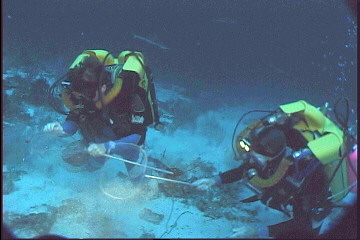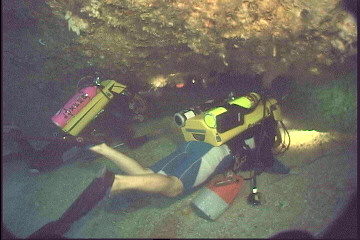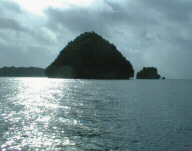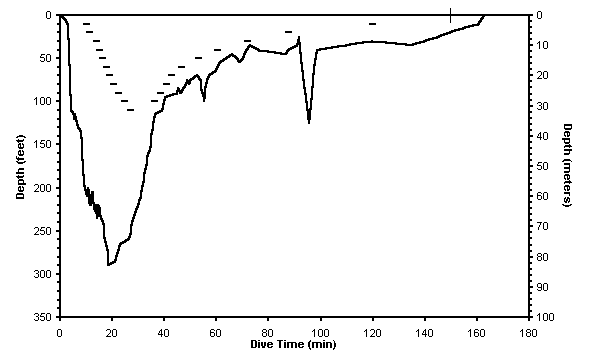Daily Log Report for
11
May 1997
Submitted by Richard Pyle
 Today was a very important and
meaningful day for me. Eleven years ago this summer, I
was 19 years old and stubbornly stupid. A dive I made
back then at Palau's Blue Holes nearly cost me my life,
or at least my ability to walk, when I earned myself a
severe case of decompression
sickness or the "bends". The story of that incident is long and
complex, but it began with a magnificent dive on the
sandy slope below Blue Holes, and ended with me becoming
paralyzed from the collarbone down. I have been waiting
eleven years to return to Palau and visit the Blue Holes
once again, and today I finally had my chance.
Today was a very important and
meaningful day for me. Eleven years ago this summer, I
was 19 years old and stubbornly stupid. A dive I made
back then at Palau's Blue Holes nearly cost me my life,
or at least my ability to walk, when I earned myself a
severe case of decompression
sickness or the "bends". The story of that incident is long and
complex, but it began with a magnificent dive on the
sandy slope below Blue Holes, and ended with me becoming
paralyzed from the collarbone down. I have been waiting
eleven years to return to Palau and visit the Blue Holes
once again, and today I finally had my chance. Today's dive began the same way
the fateful dive did -- with a descent through the
northern-most "chimney" hole into the large
cavern, then out the mouth and down the sandy slope in
front. As I drifted down, this time afforded clarity of
thought by the helium in my breathing gas mixture, I
began to vividly remember how it looked 11 years ago -
exactly the same as it does now. I saw groups of Pseudanthias
lori around coral rock outcroppings in the pure
white sand. I stopped for a moment and gazed back up the
slope, remembering the heavenly view as though I had been
there only yesterday. Because of the bright white sand
below us, clear water, and mid-day sun, it was
surprisingly bright at depth. I barely noticed the 5 or 6
chunky Grey Reef sharks that were swarming about
(although, as can be seen in the photo above, they were
most certainly around!). After a brief moment of
reminiscing, I turned and continued down the slope in
search of new species. And new species we found! The
first species John and I collected was a wrasse that we
think is in the genus Cirrhilabrus.
It's a rather striking fish (the photo doesn't do it
justice), and we found it in abundance. We collected two
other (probably new) wrasses, as well as a dottyback that bears my name (but
wasn't named in honor of me). As always, I wish I could
have stayed down all day, but we had a schedule to adhere
to, so reluctantly we started our ascent. On the way back
up to the cavern, at a depth of about 200 feet, we were
met by a somewhat severe down-current. With the
rebreather on my back, it was a non-issue because I had
many hours of extra breathing gas time on my back. I
couldn't help think, however, about how very stressful
that situation would be to a diver using conventional
scuba, impaired by narcosis and with a very limited gas
supply at that depth.
Today's dive began the same way
the fateful dive did -- with a descent through the
northern-most "chimney" hole into the large
cavern, then out the mouth and down the sandy slope in
front. As I drifted down, this time afforded clarity of
thought by the helium in my breathing gas mixture, I
began to vividly remember how it looked 11 years ago -
exactly the same as it does now. I saw groups of Pseudanthias
lori around coral rock outcroppings in the pure
white sand. I stopped for a moment and gazed back up the
slope, remembering the heavenly view as though I had been
there only yesterday. Because of the bright white sand
below us, clear water, and mid-day sun, it was
surprisingly bright at depth. I barely noticed the 5 or 6
chunky Grey Reef sharks that were swarming about
(although, as can be seen in the photo above, they were
most certainly around!). After a brief moment of
reminiscing, I turned and continued down the slope in
search of new species. And new species we found! The
first species John and I collected was a wrasse that we
think is in the genus Cirrhilabrus.
It's a rather striking fish (the photo doesn't do it
justice), and we found it in abundance. We collected two
other (probably new) wrasses, as well as a dottyback that bears my name (but
wasn't named in honor of me). As always, I wish I could
have stayed down all day, but we had a schedule to adhere
to, so reluctantly we started our ascent. On the way back
up to the cavern, at a depth of about 200 feet, we were
met by a somewhat severe down-current. With the
rebreather on my back, it was a non-issue because I had
many hours of extra breathing gas time on my back. I
couldn't help think, however, about how very stressful
that situation would be to a diver using conventional
scuba, impaired by narcosis and with a very limited gas
supply at that depth.
 Once back in the Blue
Holes cavern, we started our decompression (I can think
of many, many less interesting places to spend a couple
of hours!). In the back of the main Blue Holes cavern, at
a depth of about 70 feet, there is a small crack about 3
feet high and 20 feet wide. For more than a decade I have
wondered what was inside that crack, so today I decided
to look inside. It leads to a small room about 40 feet
wide, 10 feet back, and extending 30 feet upward. In the
lower right corner of the "entrance room",
there is a small restriction about 5 feet by 3 feet, with
nothing but blackness inside. I called John over and we
both entered the "entrance room", and I stuck
my head inside the restriction. Through the air-clear
water, the beam from my 70-watt light disappeared into
blackness with no sign of floor, ceiling, or walls in any
direction! There is an enormous room in there -
probably bigger than the entire Blue Holes cavern! John
and I are anxious to look around for fish in there, so we
will return in a couple of days with the right equipment.
Once back in the Blue
Holes cavern, we started our decompression (I can think
of many, many less interesting places to spend a couple
of hours!). In the back of the main Blue Holes cavern, at
a depth of about 70 feet, there is a small crack about 3
feet high and 20 feet wide. For more than a decade I have
wondered what was inside that crack, so today I decided
to look inside. It leads to a small room about 40 feet
wide, 10 feet back, and extending 30 feet upward. In the
lower right corner of the "entrance room",
there is a small restriction about 5 feet by 3 feet, with
nothing but blackness inside. I called John over and we
both entered the "entrance room", and I stuck
my head inside the restriction. Through the air-clear
water, the beam from my 70-watt light disappeared into
blackness with no sign of floor, ceiling, or walls in any
direction! There is an enormous room in there -
probably bigger than the entire Blue Holes cavern! John
and I are anxious to look around for fish in there, so we
will return in a couple of days with the right equipment.
 We are all having a
wonderful time so far! Everyone is enjoying the fantastic
diving that Palau offers - even our fearless producer,
Tom Lucas (pictured at left waving to his wife Shari).
We are all having a
wonderful time so far! Everyone is enjoying the fantastic
diving that Palau offers - even our fearless producer,
Tom Lucas (pictured at left waving to his wife Shari).
 The rock islands of
Palau are, off course, spectacular! We spent some time in
the boats cruising along the mirror-flat, crystal clear
waters in among these distinctive, undercut limestone
islands. Palau is truly a remarkable place that needs to
be protected.
The rock islands of
Palau are, off course, spectacular! We spent some time in
the boats cruising along the mirror-flat, crystal clear
waters in among these distinctive, undercut limestone
islands. Palau is truly a remarkable place that needs to
be protected.
Tomorrow, the film crew will return to Blue Holes to continue filming fish and reef scapes, while John, Pat and I will go back to Augulpelu reef for more fish collecting. It will be a relaxing day for us tomorrow, allowing some badly-needed rest and time to fix a regulator or two. Watch this space...
